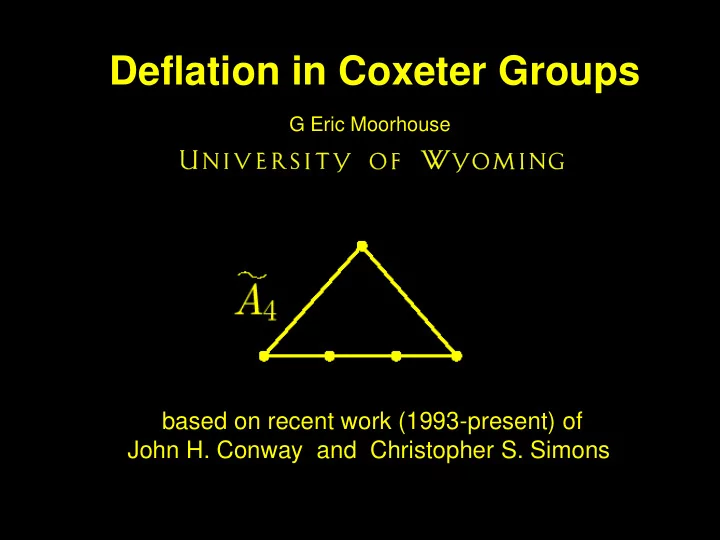

Deflation in Coxeter Groups G Eric Moorhouse based on recent work (1993-present) of John H. Conway and Christopher S. Simons
The cube defines an infinite Coxeter group.
The cube has four 6-cycles (as induced subgraphs).
~ Deflate every A 5 to an A 5 . This can be done by imposing an additional relation s 1 s 2 s 3 s 4 s 5 s 6 s 5 s 4 s 3 s 2 = 1 for every 6-cycle.
~ Deflate every A 5 to an A 5 . The resulting homomorphic image is a finite group isomorphic to PSp 4 (3) × 2 = U 4 (2)×2 of order 51840.
Let G be a finite group generated by a set of n elements of order 2. Then G is a homomorphic image of a Coxeter group defined by a graph on n vertices. But this presentation is not usually very concise. We would prefer n to be very small relative to | G |. Problem: Find groups G having a concise presentation obtained by deflating a Coxeter group. Examples grow on trees!
The graph Y 111
~ Close A 3 to form A 3
Goal: Close every 3-path to a 4-cycle, adding as few vertices as possible.
Interesting examples arise also from: ~ Y 222 (7 vertices) Deflate every A 6 to A 6 Close induced The resulting group is 5-paths to 6-cycles PSp 4 (3):2 = U 4 (2):2 of order 51840 Yields the Petersen graph (10 vertices)
Interesting examples arise also from: ~ Y 333 (10 vertices) Deflate every A 8 to A 8 Close induced The resulting group is the 7-paths to 8-cycles – (2):2 group O 8 of order 394,813,440 Yields the incidence graph of PG 2 (2) (14 vertices)
Interesting examples arise also from: ~ Y 555 (16 vertices) Deflate every A 12 to A 12 Close induced The resulting group is the 11-paths to 12-cycles Bimonster ( M × M ):2 of order ≈ 1.31 ×10 108 Yields the incidence graph of PG 2 (3) (26 vertices)
Theorem (Ivanov-Norton, 1992) The Bimonster ( M × M ):2 is presented by the Coxeter group of the graph Y 555 with the single additional relation ( ab 1 c 1 ab 2 c 2 ab 3 c 3 ) 10 = 1. c 1 c 3 a b 1 b 3 b 2 c 2
V = R 3 k +1 is the set of all vectors v 12 … v 11 v 1 k v 21 v 12 … v 2 k v ∞ V = v 31 v 32 … v 3 k with the Lorentzian inner product v • w = v 11 w 11 + v 12 w 12 + … + v 3 k w 3 k – v ∞ w ∞ Vertices are represented by vectors v 1 , v 2 ,…, v n such that v i • v j = 2. Vertices i , j are joined whenever v i • v j = ± 1 (but possibly for other nonzero values of v i • v j as well).
0 … 0 0 1 0 … 0 0 1 1 0 … 0 0 1
… 0 0 0 0 … – 1 0 0 1 … – 1 0 0 1 0 … 0 0 0 0 0 … 0 0 0 0 … 0 0 0 0 0 … 0 0 1 0 … 0 0 1 1 0 … 0 0 1 … 0 0 0 0 … 0 0 0 0 0 … – 1 0 0 1
… 0 0 0 0 … – 1 … – 1 0 1 0 0 1 0 0 … … 0 0 0 0 0 0 0 0 0 … 0 0 0 0 … 0 0 0 0 … – 1 0 0 1 … – 1 0 0 1 0 … 0 0 0 0 0 … 0 0 0 0 … 0 0 0 0 0 … 0 0 1 0 … 0 0 1 1 0 … 0 0 1 … 0 0 0 0 … 0 0 0 0 0 … – 1 0 0 1 The graphs Y kkk … 0 0 0 0 … 0 0 0 0 0 … – 1 0 1 0
MAPLE demonstrations Y 222 Y 333 Y 555
Recommend
More recommend